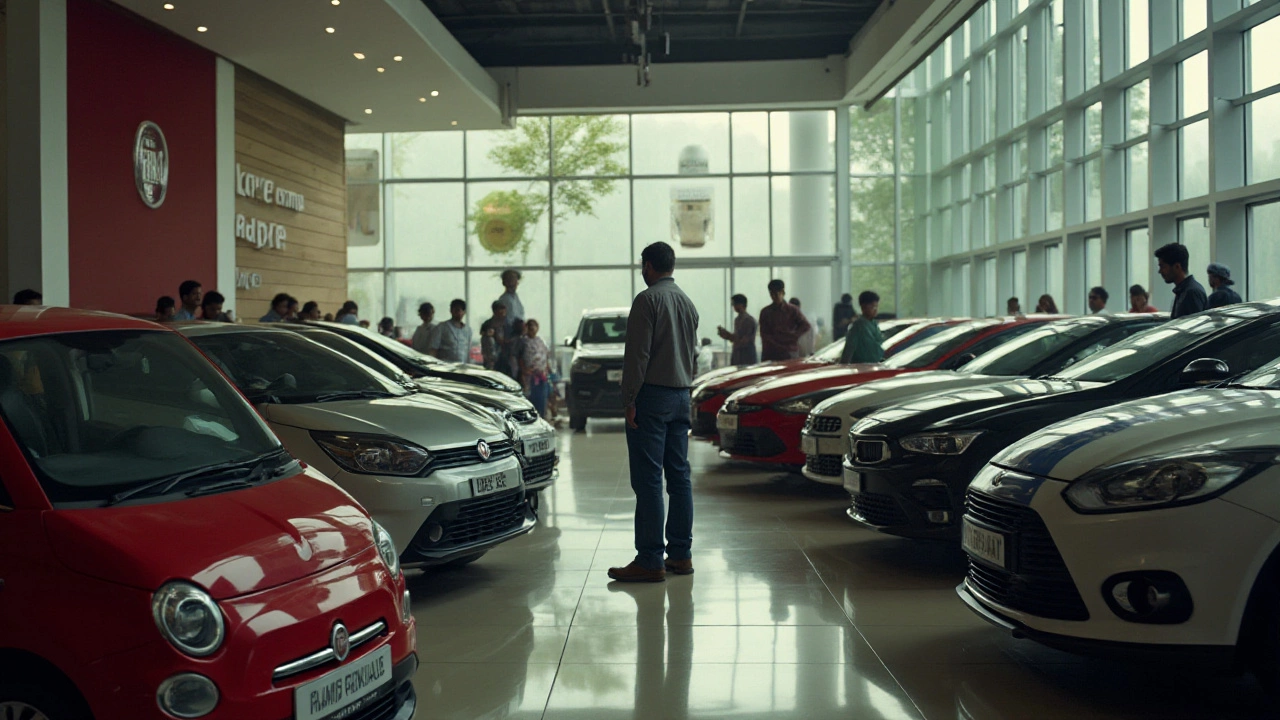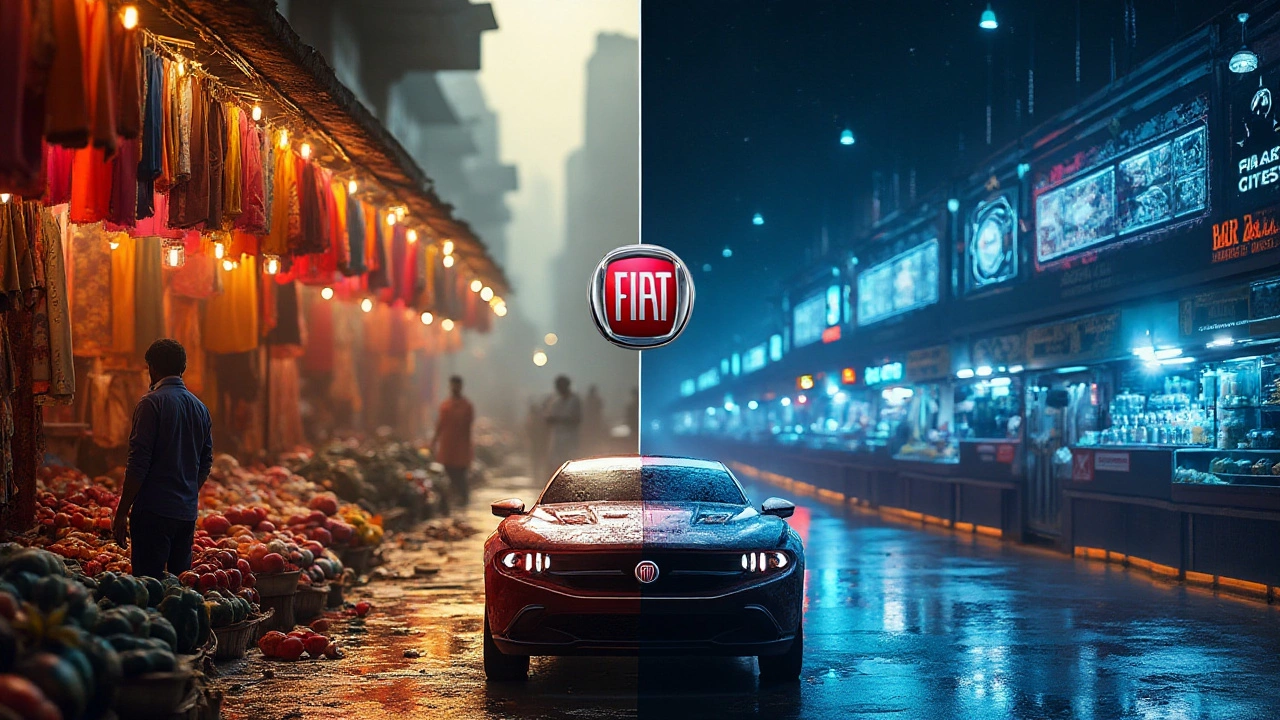Fiat, a name that once resonated with Indian car enthusiasts, bid adieu to the Indian market in a move that surprised many. It wasn't an abrupt decision, but a result of numerous challenges that the company faced over the years.
Though Fiat cars were once synonymous with quality and style, the brand struggled to keep pace with the changing dynamics and preferences of the local market. From strategic decisions that didn't pan out to an intensely competitive environment, the reasons for their exit are manifold.
This article spells out the journey of Fiat in India and deciphers what went wrong along the way. It's a reflection not only on the fate of one company but on the broader challenges that international brands encounter when navigating the unique complexities of the Indian automobile industry.
- A Brief History of Fiat in India
- Challenges Faced by Fiat
- Market Competition and Changing Consumer Preferences
- Strategic Decisions and Missteps
- Lessons for Foreign Automakers in India
A Brief History of Fiat in India
Embarking on its Indian journey in the early 1950s, Fiat quickly became a familiar name on the streets of India. Its collaboration with the Premier Automobiles Ltd initially brought the much-loved Fiat 1100, locally known as the Premier Padmini, to life. This car wasn't just a vehicle; it became a symbol of luxury and style among the Indian elite. These robust and elegant models captured the imagination of Indian drivers, becoming an integral part of the country’s automobile universe. Fiat continued to thrive for decades, with its cars becoming preferred choices for families and taxi operators alike due to their reliability and ease of maintenance.
However, by the 1990s, with India's economy opening up and liberalization in full swing, the landscape began to change drastically. This new chapter in India's automotive sector offered a double-edged sword for Fiat. On one side, the newfound economic policies opened avenues for Fiat to present an expanded lineup, but on the other, rising competition from foreign brands posed significant challenges. By the mid-1990s, Fiat introduced the Uno in India, a move that sparked significant excitement. The anticipation was immense, and the Uno was expected to be a game-changer, although various challenges, including logistical hurdles, dampened the enthusiasm considerably.
Continuing its pursuit to capture a larger share of the market, Fiat eventually came under a joint venture with Tata Motors in 2006, aiming to leverage Tata's extensive distribution network and local expertise. The collaboration envisioned renewed prosperity through a diverse portfolio that featured models like the Linea and Punto. However, the association did not flourish as expected. Issues like dealer dissatisfaction and service shortcomings frequently cropped up. Ultimately, both parties decided to part ways in 2012, signing a new phase of struggles for Fiat in the subcontinent. The recurring hurdles that Fiat faced were not lost on industry observers. In an analysis by the respected economic journal "The Economic Times", it was noted that
'Fiat's missteps and inability to adapt swiftly to the fast-evolving market dynamics led to its gradual retreat.'
Fiat's story in India is a tale of early success but ultimate withdrawal. It underlines the complexities faced by a global brand trying to adapt to a diverse and rapidly transforming market like India's. Their journey reflects the inherent challenges faced by foreign automakers – a tough balancing act between understanding local preferences and maintaining brand identity. Fiat’s journey serves not just as a historical recounting but as a valuable lesson for other international companies eyeing expansion in the Indian market, to focus not just on strong products but also strategic alignments and vocal consumer engagement.
Challenges Faced by Fiat
The fascinating yet tumultuous journey of Fiat in India encapsulates a myriad of challenges that are both complex and multifaceted. The brand, which was once a household name through models like the Fiat Premier Padmini, found itself battling a plethora of hurdles over the years. A dominant factor contributing to Fiat's struggles was the sheer intensity of competition in the Indian automobile industry. With domestic giants such as Maruti Suzuki dominating the scene, and international competitors like Hyundai and Honda bringing innovation at competitive prices, Fiat had a hard time carving out its niche.
Fiat consistently grappled with branding issues. While their cars were built on robust engineering foundations, the lack of a coherent brand strategy meant their differentiation in the market remained weak. This fractured consumer perception over time. Another critical challenge was the frequently shifting consumer preferences in India. As buyers gravitated towards SUVs and compact cars offering a slew of features at attractive price points, Fiat hadn’t adapted quickly enough to meet those evolving demands. Their product lineup, which at times seemed outdated compared to newer arrivals, further hamstrung their ability to captivate potential customers.
Let's dip into the operational front, where myriad challenges lurked in spare parts availability and service network quality. Fiat’s after-sales service was often critiqued for not meeting the expansive support required by Indian consumers, which discouraged potential buyers wary of maintenance costs. There are moments captured by industry observers where Fiat’s supply chain inefficiencies meant crucial delays, denting their brand loyalty. The company also wrestled with policy challenges. The Indian government's stringent emission norms and policy shifts posed significant adaptation pressures on their traditional engineering approaches.
Interestingly, Fiat also didn't capitalize on its global lineage and technological advancements. A quote from Sir Ratan Tata himself once highlighted, "Fiat has the technology, what it needs is the aggression to swiftly meet today’s dynamics." Despite such potential, Fiat hesitated to bring its advanced engines and innovations to the Indian market, missing opportunities that its European and American rivals exploited successfully.
A snapshot to consider would be the customer satisfaction rankings, where Fiat often lagged behind due to perceived deficits in value. Such challenges cumulatively weakened their foothold, eventually leading to their exit. For future international brands eyeing the Indian market, Fiat's story serves as a reminder of the intricate dance required between understanding customer needs, operational excellence, and robust strategy execution.

Market Competition and Changing Consumer Preferences
India's automotive industry is a hotbed of rivalry, with numerous players vying for a slice of the lucrative market. For Fiat, this competition was more than just a race; it was an uphill battle against deeply entrenched local champions and powerful international newcomers. Maruti Suzuki and Hyundai, for instance, have dominated Indian roads with their incredible market reach and understanding of local tastes. Maruti, with its robust after-sales network and affordable pricing, created a benchmark that Fiat found difficult to match. Hyundai, on the other hand, brought in the allure of innovation and style, capturing the imagination of the tech-savvy younger population who were seeking more than just a commuter vehicle from Fiat in India.
Such was the intensity of competition that Fiat couldn't carve out a comfortable niche for itself. Consumer preferences were also rapidly evolving, influenced by several factors ranging from economic growth to digital media exposure. The Indian buyer of the 2020s isn't just looking for a vehicle that provides comfort; they want connected cars with cutting-edge technology. Fiat, often perceived as lagging in these aspects, struggled to shed its image as an old-school brand amidst the fierce race to be the most innovative. The lack of models catering to these emerging needs and the aggressive model pipeline of rivals compounded Fiat’s plight, leading their once-loyal customers to eventually stray.
"Fiat failed to bring in products that could resonate with new-age buyers," remarked an industry insider from the Indian automotive sector, highlighting the disconnect between Fiat's product strategy and market demands.Automakers like Tata and Mahindra capitalized on national pride, offering Made-in-India vehicles that appealed massively to the market's sentiment-driven segments. They were conscious of India's burgeoning hybrid and electric car aspirations and aligned their offerings accordingly. Fiat’s product lineup, in contrast, didn’t quite meet these expectations nor fit into the eco-friendlier agenda that a growing fraction of the populace is adopting.
Moreover, affordability remains crucial in India. While Fiat’s cars were praised for their sturdy build and driving dynamics, they were not priced competitively enough compared to rivals offering similar or superior features. Customers have become more value-conscious, seeking exceptional offerings within tight budgets. Such disconnects in pricing strategy further pushed Fiat to the fringes. Automobile industry experts frequently underline the need for foreign brands to not only adapt to local tastes but also to offer flexible pricing so as to resonate on a larger scale. It’s clear Fiat’s struggle wasn’t just about competition; it was about finding a balance between their global identity and Indian consumers’ preferences, something that remains a challenge for many international brands to this day.
Strategic Decisions and Missteps
Fiat's journey in India has been a rollercoaster of ambitious decisions and unfortunate missteps. In the beginning, Fiat made a commendable effort to capture the market with a lineup of modern cars that appealed to the Indian buyer's sense of affordability and style. However, as the automobile landscape began to shift rapidly, Fiat's choices did not adapt quickly enough. One of their biggest miscalculations was focusing heavily on launching multiple models without establishing a strong foundational dealership and service network. This oversight left many customers dissatisfied with after-sales service, a crucial aspect for sustainability in the competitive **Indian market**.
Additionally, the company's decision to keep its product portfolio largely unchanged over several years acted as a stumbling block. During the time when other automakers like Maruti Suzuki and Hyundai were introducing fresh designs and innovative features, Fiat's offerings seemed outdated. They did attempt to rebadge some models through partnerships, but this move did not translate into the brand loyalty they were hoping for. The highly anticipated Fiat Punto and Linea models, although impressive, couldn't maintain market interest due to this stagnation.
Failed Collaborations and Economic Constraints
Collaborations with other brands could have been a winning strategy, but for Fiat, it was a mixed bag. Their tie-up with Tata Motors was intended to enhance distribution and service reach across India. Unfortunately, differences in operational philosophies and execution styles led to rather disappointing outcomes. According to industry analysts, Fiat's lack of autonomy in decision-making during this partnership created hesitations in expanding their own network adequately. The economic climate also proved challenging. The Indian economy faced periods of slowing growth, which affected automobile sales broadly, but Fiat's less aggressive adaptation strategies meant that they bore the brunt more severely than some of their competitors.
Paul Tan, a well-known automotive expert, once commented, "While Fiat had the potential to captivate the Indian car buyer's imagination, their strategic misfires in market positioning and brand alignment resulted in underperformance."
Marketing Missteps and Brand Perception
On the marketing front, Fiat failed to carve a distinctive identity in the midst of a competitive **automobile industry**. Many Indian consumers were unclear about what Fiat really stood for, leading to confusion and consequently, low brand recall. The absence of a strong marketing narrative prevented Fiat from differentiating itself from brands that were aggressively marketed, such as Honda and Toyota. Despite having a legacy of performance and European craftsmanship, Fiat didn't play heavily on these strengths when wooing consumers in India.
Perhaps the most telling misstep was the neglect of emerging trends in the **automobile industry**. As the industry began veering towards greener technologies and fuel-efficient vehicles due to rising environmental awareness, Fiat lagged in introducing any viable electric or hybrid options. This crucial gap in their strategy was a missed opportunity in a market that was gradually shifting toward sustainability. These missteps resulted in dwindling market share and eventually the difficult decision to cease production and exit the country.

Lessons for Foreign Automakers in India
For any foreign automaker contemplating a foray into or maintaining a foothold in India, the exit of Fiat holds numerous lessons that are instrumental in shaping strategies. Fiat's journey was one fraught with numerous hurdles, but it also offers a roadmap of what to avoid. One of the primary lessons is the critical importance of understanding the local market dynamics. India is a country of myriad tastes, preferences, and economic conditions, requiring companies to offer products that cater to varied consumer needs. A one-size-fits-all strategy doesn't work here, and what works in Europe or the US may not necessarily strike a chord with Indian buyers. Companies need to focus on localizing their products, which means not just modifying the technical aspects but also marketing strategies to fit the cultural fabric of the country.
Another crucial takeaway is the significance of competitive pricing. While Fiat had established its reputation as a premium brand, it faced stiff competition from more price-competitive brands in India. The local automobile market is fiercely competitive, with players like Maruti Suzuki and Hyundai dominating the scene, offering vehicles that are both affordable and feature-rich. This means foreign players need to strike a balance between maintaining brand prestige and ensuring their vehicles are economically viable for the average Indian consumer. A nimble pricing strategy, perhaps incorporating tiered offerings, could be a solution to this complex challenge.
Fiat India's struggles also underscore the need for robust after-sales service and widespread availability of service centers. In a vast country like India, the importance of service network coverage can't be overstated. Many consumers shy away from brands perceived as not having adequate service support, which was one of the criticisms Fiat faced. Establishing a reliable service framework ensures customer trust and enhances brand loyalty. Automakers need to allocate resources not just for the sales network but also for service locations, ensuring customers across regions have seamless access to maintenance and support.
"Given India's youth demographic, foreign automakers must focus on innovation and tech appeal," noted a renowned industry analyst. "Connecting with the younger population through technology and eco-friendly solutions could turn the tide for foreign brands."Moreover, companies must also tap into the burgeoning youth demographic to drive growth. Younger buyers are increasingly tech-savvy and environmentally conscious, valuing features like connectivity, digital interfaces, and fuel efficiency. By investing in technology and features that resonate with this generation, foreign brands can carve out a niche in India's expanding automobile market. Innovation often acts as a catalyst for change, providing just the edge overseas automakers need to stand out among established local giants.
Finally, adaptability and cultural sensitivity remain key factors in establishing a robust presence in India. Embracing local customs, traditions, and consumer behavior can influence everything from marketing copy to design elements. Employing a diverse team that understands these dynamics can lend significant authenticity to foreign operations. Ultimately, as Fiat's story illustrates, failing to adapt to these multifaceted factors can lead to a retreat, but recognizing and incorporating these insights can be the cornerstone of success for international automotive brands in India.
